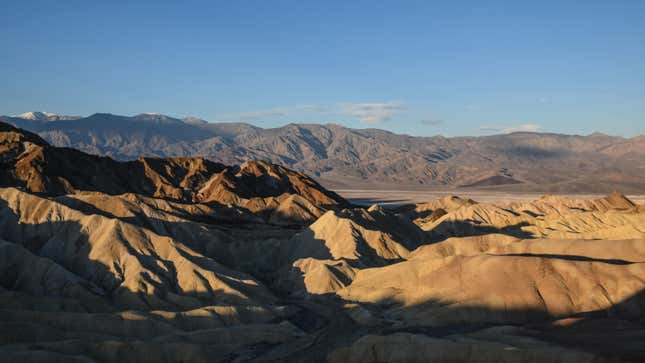
For the hottest place in the U.S. to make news, it has to be pretty damn hot. And folks, it’s pretty damn hot.
The Summers in Death Valley aren’t for the faint of heart, but things are downright ridiculous right now. The official weather station at Furnace Creek, California registered a high of 128 degrees Fahrenheit (53.3 degrees Celsius) on Sunday. That’s a degree shy of the all-time hottest reliable temperature ever recorded on Earth (recorded in, where else, Death Valley in 2013). The scorching heat record comes as much of the rest of the country bakes under a sweltering heat wave. But hey, at least it could be worse?
The U.S. has been seared under a series of heat domes over the past few weeks. Basically, heat domes are areas of high pressure have locked in sunny skies and soaring temperatures, which in turn reinforce the high pressure. The Southwest has been one of the epicenters of heat. Over the weekend, the most intense heat centered on the hottest place imaginable in Death Valley at the hottest time of the year in July, which is how you get to 128 degrees Fahrenheit. That’s the hottest the temperature the valley has seen since 2017 when breaking things down to tenths of degrees. And it’s just shy of the 129 degrees Fahrenheit (53.9 degrees Celsius) record set in 2013. Just two years ago, Death Valley also recorded the hottest month anywhere on Earth.
I should note just what constitutes the all-time daily heat record here is in some dispute. It was reportedly hotter in 1913, but there are questions about the accuracy of the data. Seriously, if you wanna start a meteorologist fight, this is a hot topic (sorry).
Anyways, the record heat is hardly limited to Death Valley. Las Vegas has set a string of daily low and high records, including Monday when the coolest temperature recorded was 94 degrees Fahrenheit (34.4 degrees Celsius). Closer to the U.S.-Mexico border, Nogales, Arizona hit 110 degrees Fahrenheit (43.3 degrees Celsius) on Monday, smashing its former daily record. Excessive heat warnings and heat advisories run from California’s Central Valley clear through to the Florida Gulf Coast. Suffice to say, the South is off-the-charts hot.
If you don’t live there, fret not. You, too, will soon likely suffer from abnormal warmth. The Southwest’s heat dome will push east and eventually merge with another blast of hot air coming out of Canada. This will form a fucking wicked huge heat dome (technical term) that parks itself over basically the entire U.S. by this weekend.
That’s shunted the jet stream to the north, allowing warm air to balloon up from the south, bringing misery for everyone. Record heat is one of the clearest signs of the climate crisis hitting home. The mechanism is pretty simple: raise the background temperature through carbon pollution, raise the odds and magnitude of concentrated heat waves. We’ve seen this time and time again in recent years, whether it’s sweltering conditions in Europe last year (and the year before that) or Siberia right now (and the year before and year before that because we almost, quite literally, live in hell).
The coronavirus pandemic is throwing a new wrinkle into the excessive heat, at least in the U.S. where the hottest states in the country are currently also the current epicenters of the virus. While some states are blindly forging ahead with reopening, others are more cautious. That’s good for coronavirus, but it makes it hard during a heat wave to have pools close. And even where infections are in decline or mostly stamped out, it could still be a risky proposition to visit cooling centers if proper social distancing measures or good ventilation aren’t in place. So actually, I changed my mind. Maybe it can’t, in fact, get worse.
Update, 7/31/20, 12:10 p.m.: This post has been updated to reflect the proper Celsius conversion for this month’s Death Valley heat.